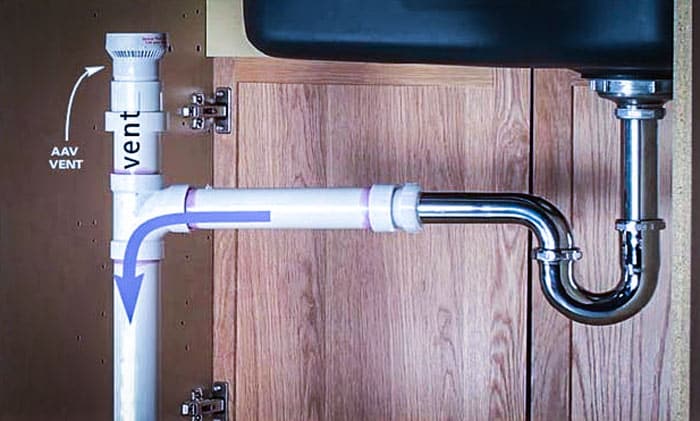What're your ideas about What Is A Plumbing Vent & How Do They Work??

Appropriate ventilation in pipes systems is often forgotten, yet it is important for maintaining the performance and security of your home's pipes. Ventilation aids control atmospheric pressure, prevent the accumulation of hazardous gases, and guarantee the efficient removal of waste. In this overview, we will certainly discover the significance of appropriate plumbing air flow, just how it works, and the benefits it brings to your pipes system.
Just How Air Flow Works in Plumbing Systems
Air Pressure Regulation
Proper ventilation keeps balanced air pressure within the pipes system. When water streams through pipelines, it displaces air. Without appropriate ventilation, this displacement can produce negative stress, causing slow drains or siphoning of water from catches, which can trigger unpleasant odors to seep right into the home.
Stopping Sewage System Gas Buildup
Among one of the most important features of plumbing vents is to prevent drain gases, such as methane and hydrogen sulfide, from building up within the home. These gases can pose severe wellness risks and are very flammable. Vent pipes enable these gases to leave securely outdoors.
Aiding in Waste Removal
Ventilation helps in the effective removal of wastewater by protecting against airlocks in the water drainage system. When air can stream freely via the vents, it permits water and waste to flow smoothly via the pipes, minimizing the risk of blockages and back-ups.
Advantages of Correct Ventilation
Boosted System Effectiveness
Properly ventilated pipes systems run more efficiently, with fewer obstructions, faster draining, and much less strain on the pipelines. This efficiency expands the life expectancy of the plumbing system.
Improved Air High Quality
By preventing sewage system gases from entering your home, correct air flow contributes to better interior air high quality, making your living atmosphere healthier and extra comfy.
Avoiding Water Damages
Appropriate air flow aids stop water from being siphoned out of catches, which can bring about drain gases getting in the home and triggering water damages in time.
Steps to Guarantee Correct Ventilation
Consulting Plumbing Codes
Constantly get in touch with regional pipes codes when creating or customizing your plumbing system. These codes supply the needed standards for appropriate venting and ensure your system satisfies security standards.
Routine Inspection and Maintenance
Regular assessments can assist identify potential ventilation concerns before they come to be significant troubles. Upkeep tasks, such as cleaning up vent pipelines and looking for blockages, are crucial for maintaining the system in good working order.
Professional Installment
For brand-new setups or significant alterations, it's important to employ a professional plumber. They have the expertise to make sure the ventilation system is properly developed and set up according to code.
Understanding Ventilation in Plumbing
Air flow in plumbing refers to the network of pipelines that permit air to flow via the drain system. These vents serve numerous purposes, consisting of controling air pressure within the pipes, stopping drain gases from going into the home, and assisting in the smooth circulation of wastewater.
Sorts Of Pipes Vents
Main Heap Vent
The primary pile vent, additionally known as the vent pile, is the main vent in a pipes system. It prolongs from the main drain align with the roofing system, enabling gases to escape and fresh air to go into the system.
Branch Vent
Branch vents link to the primary stack vent and serve specific fixtures, such as sinks, toilets, and showers. These vents make sure that each component has appropriate ventilation to work effectively.
Air Admission Shutoff (AAV).
An Air Admission Shutoff (AAV) is a one-way valve that allows air to enter the plumbing system without the need for a conventional vent pipeline expanding with the roofing. AAVs are generally used in improvements or locations where setting up a conventional vent is unwise.
Indicators of Poor Ventilation in Plumbing.
Slow Draining Fixtures.
If your sinks, tubs, or commodes are draining slowly, it could be an indicator of inadequate ventilation. Inadequate air flow can develop a vacuum result, making it tough for water to drain correctly.
Gurgling Sounds.
Gurgling noises originating from drains are frequently an outcome of air being sucked via water traps due to unfavorable stress in the pipelines. This is a clear indicator of inadequate air flow.
Undesirable Smells.
Sewage system odors inside your home are a red flag that your plumbing system is not appropriately ventilated. This might suggest that drain gases are not being appropriately aired vent outside, leading to possibly dangerous conditions.
Typical Air Flow Blunders.
Poor Vent Sizing.
Making use of small air vent pipes can lead to poor air circulation and stress imbalances in the system. It's necessary to use vents that fulfill the certain requirements of your pipes system.
Improper Vent Placement.
Placing vents also far from the components they serve can reduce their performance. Proper positioning makes sure that air can move freely and successfully with the system.
Disregarding Code Demands.
Building regulations provide certain standards for plumbing ventilation. Disregarding these codes can result in a system that fails to function properly and may lead to pricey fixings or health hazards.
Verdict.
Proper ventilation is an essential component of any pipes system, making sure that it operates successfully and securely. By recognizing the relevance of air flow, acknowledging the signs of poor air flow, and taking actions to maintain your system, you can prevent pricey problems and safeguard your home's air quality.
4 Things You Should Know About Your Plumbing Vents
What Plumbing Vents Are
Also called a vent stack, a plumbing vent is a vertical pipe attached to your drain line that runs through your roof. The plumbing vent pipe, or plumbing air vent, removes gas and odors from your plumbing system and allows fresh air to enter the pipes, helping the water to flow out of the drain pipes.
What Plumbing Vents Do
Plumbing vents have two basic functions. One of which is to allow unpleasant smelling wastewater and sewer gasses to escape your plumbing system instead of entering your home. Plumbing vent pipes are typically located on roofs, away from windows, to ensure the fumes exit the home completely.
The other function of the plumbing vent is to move fresh air into your plumbing system. This helps move water through every plumbing fixture in your house, like toilets and sink drains. Think of the way in which you need to let a little air into the bottle as you pour soda in order to make the drink flow smoothly.
Different Types of Plumbing Vents
True vent: This is the most common vent option. In simplest terms, a true vent is a vertical pipe attached to your drain line that exits through the roof. They often function as the main vent that other fixtures can connect to. Re-vent pipe or auxiliary vent: Attached to the drain line near specific plumbing fixtures, re-vent pipes run up and over to connect to the main vent. Common vent: Two plumbing fixtures installed on opposite sides of a wall are typically tied into the vent stack using something known as a sanitary cross. Wet vent: This venting option operates as a drain pipe and a vent at the same time. Wet vent drainage systems drain water from one fixture while venting the air from another. Although they’ve been used for over 100 years, wet vent systems have only recently been added to the plumbing code in many areas. If you’re planning on installing one in a bathroom remodel, make sure you check your local code prior to construction. Loop vent: For free-standing fixtures like kitchen island sinks, loop vents are ideal. These vent pipes run under the floor, rise from the P-trap, and create a loop inside the cabinet sink. Air admittance valve: An AAV is a one-way mechanical valve typically installed at the site of the plumbing fixture. AAVs allow venting to occur without having to tie into a larger venting system. They’re ideal for venting fixtures where you aren’t able to easily connect to an existing vent system. Common Plumbing Vent Issues
Although vent pipes typically don’t have water flowing through them, they’re still subject to many typical plumbing issues. For example, clogs are one of the most common problems associated with sewer vent pipes. If your vent pipe gets clogged, all of your plumbing fixtures tied into the vent stack will be affected.
A sink with a slow drain that bubbles and gurgles or a strong sewage smell around your toilet are both indicators that your toilet vent pipe is clogged. Because most vent pipes exit through the roof, old leaves, twigs or even a bird’s nest could be clogging the pipe.
Clogs in your vent pipe system cause a buildup of negative pressure, meaning that water won’t be able to flow out of your home very well. It’s similar to putting your finger over the opening of a straw to trap water inside. When you remove your finger, the water is able to flow out of the straw.
If you suspect you have any blockage in your vent, make sure you have a professional come examine the situation. Left unchecked, a blocked air vent can lead to other costly repairs, like leaks and sediment buildup.
Under Pressure
Pipe vents are essential aspects of a home’s plumbing system. Owning a home means learning about all sorts of things you never put much thought into before. But by understanding as much as you can about the important systems of your home, you can keep those budgets intact and those anxiety levels low.
https://www.homeserve.com/en-us/blog/home-improvement/plumbing-vents/

I am just very interested by What Are Plumbing Vents and Why Are They Important? and I really hope you enjoyed reading our blog post. Sharing is nice. Helping others is fun. Thanks a lot for your time. Revisit us soon.
Contact